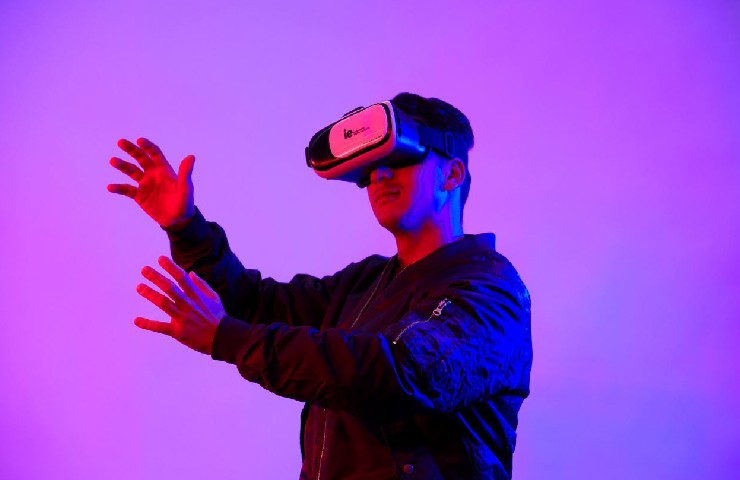19/01/2023
The metaverse is a hot topic—but what is it exactly? And what does it mean for the customer experience (CX)? We take a look at how tech trends such as augmented reality (AR) and virtual reality (VR) are shaping the development of CX, and why you need to know about them.
Although the term “metaverse” was first used in Neal Stephenson’s remarkably prescient 1992 science fiction novel Snow Crash, the technology which makes this vision possible has only recently reached maturity. Simply put, the metaverse is an integrated virtual environment that users can access through AR and VR interfaces, allowing them to interact in a digital world using 3D avatars and 3D renditions of physical surroundings.
The metaverse: past, present and future
While this technology isn’t yet mainstream in a business context, it is already widely used in applications such as gaming: Roblox, for example, positions its platform as part of the metaverse and emphasizes the importance of shared immersive experiences. Also, many brands have started realizing the commercial potential of the metaverse. Businesses that prioritize the customer experience, such as IKEA, are already creating opportunities for customers to interact virtually with their products.
Gartner predicts that almost 30% of companies will have metaverse-ready products and services by 2026. (Source: Gartner)
Elements of the metaverse are also making their way into organizational culture, with virtual reality meetings being used as an effective collaboration tool as many companies settle into hybrid working. The metaverse, unlike platforms such as Zoom or Teams, can replicate much of the social aspects of work. Ed Greig, the chief disruptor at Deloitte Digital, recounts a situation where his VR avatar ran into a colleague’s in a virtual hallway and they conversed just as they would in a physical office setting—which, he points out, would never happen in a traditional online meeting.
Moving into the metaverse: what CX professionals need to know
The metaverse may still be in its infancy, but it’s already changing the face of business and redefining trends in customer experience.
According to Accenture, 70% of CFOs believe the metaverse will lead to positive changes for their business.

Roles such as Chief Experience Officer (CXO) and Chief Customer Officer (CCO) are becoming highly-valued positions, with over 90% of companies now employing staff with these or similar job titles.
The metaverse will empower customers to traverse the virtual and physical worlds when connecting with the business of their choice, turning the notifications and transactions of the past into intelligent, real-time conversations—that is what will differentiate businesses moving forward. — Savinay Berry, Vonage (via CMSWire)
At IE University, we understand the importance of staying at the cutting edge of developments in this fast-changing environment, so we constantly update our programs to reflect the latest technological and business trends. Our Master in Customer Experience & Innovation is designed for forward-thinking individuals who want to build human-centered solutions for the physical and digital worlds.
The Master in Customer Experience & Innovation dives deep into human-centered design, service design, as well as product and experience design, in order to find innovative ways to shape customers’ experiences and deliver added value. Graduates of the program gain a skill set that prepares them to take up a wide variety of roles such as usability consultant, strategic experience designer, customer insights specialist and many more, within any type of organization.
Making the most of the metaverse: five top tips for CX strategy
1. Get up close and personal
Personalization is already an important factor in improving the customer experience, but advances in intelligent automation have enabled companies to refocus their customer offerings and marketing efforts with greater precision and relevance. Even in highly regulated sectors such as finance, the use of machine learning and data analytics to bring customers contextual, actionable messages in real time is credited with providing a competitive advantage.
According to NielsenIQ, 56% of shoppers said that AR gives them more confidence about the quality of a product; 61% said they prefer to shop with retailers that offer AR experiences. (Source: Harvard Business Review)
The metaverse offers fresh opportunities for even greater personalization through the use of avatars, already widely adopted by gaming and fashion brands. They serve a dual purpose: companies can make interactions more lifelike by using an avatar as a personal assistant instead of a text-only chatbot, while customers can create and use their own avatars online—an experience familiar to many from social media platforms. Taking this one step further, customers can interact with brands via augmented reality in ways that replicate the physical world, such as trying on clothes, playing sports or visiting a tourist destination.
2. Deliver an improved omnichannel experience
The COVID-19 pandemic forced us all to think “digital first,” but we now need to think “experience first.” An omnichannel approach means delivering the same high-quality, seamless experience across multiple channels throughout the customer journey. It acknowledges that many customers, despite often having a preferred channel, will communicate with a company in many different ways. A customer’s journey may begin online and continue in-store, on the telephone or, soon, in the metaverse. CX professionals need to be prepared for this and adapt their strategy accordingly.
Just like customers now expect availability and responsiveness on social media, they will soon come to look for a VR storefront, a 3D customer executive avatar, metaverse-ready services, user navigation through VR controllers and voice, and much more. (Source: CX Today)
The challenge for CX professionals is to integrate the metaverse into the existing channel mix—a task that has so far been limited by the constraints of technology. After all, the digital world cannot (yet) replicate all in-person interactions and VR adoption among consumers remains low due to hardware costs. However, this is changing fast and customers who are already heavy users of digital communications are more likely to become active in the metaverse.
3. Build brand loyalty: rewards and values
For brands, the metaverse can supply new and interesting use cases for developing loyalty programs, with rewards including digital assets such as non-fungible tokens (NFTs) as well as virtual events.

Concerts, films and works of art can all be offered as rewards and have the potential for a higher level of interactivity than their real-world equivalents.
Luxury brands in particular are beginning to explore these avenues, one notable example being the Gucci Garden on Roblox.
71% of people who know what the metaverse is say brands need to start thinking about its environmental impact. (Source: Wunderman Thompson Data)
The metaverse also provides an opportunity to promote a brand’s values—a concern that is of increasing importance to buyers, with 66% of global consumers and 73% of millennials reporting a willingness to pay more for sustainable goods. Further, with sustainability as the main selling point, virtual travel in the metaverse can be presented as an environmentally friendly alternative to visiting remote destinations. And although the carbon footprint of digital fashion is still a topic of debate, many fashion brands are entering the metaverse. One notable example is H&M with its innovative H&M Loooptopia Experience, an immersive game on Roblox in which users create their own clothing lines while learning more about circular fashion.
4. Provide instant, context-sensitive support
The metaverse isn’t just for sales or entertainment: it can also help you to deliver information and content in an interactive, immersive format. Your customers don’t need to wait in a physical or virtual queue; instead, they can find instant answers to common questions. Toyota’s AR app not only helps customers make purchasing decisions, but also allows them to visualize the key features and technical details of their vehicles.
Customer support is integral to digital, immersive experiences. Companies have a real opportunity to innovate their CX strategy to embrace this significant tipping point. — Adrian McDermott, Zendesk (via TechCrunch)
Other companies have developed navigation apps to assist customers in finding their way around a virtual or physical store. And the use of avatars can provide customers with a more personal, user-friendly experience in a virtual environment, such as when demonstrating a product or troubleshooting a technical query.
5. Meet your future customers where they are, whoever they are
Just as several generations of customers are “digital natives” who have no experience of life before the internet, we’re likely to see a generation of metaverse natives emerge. Young people who are currently playing the popular game Fortnite, for example, are already immersed in a virtual environment and will expect to see this replicated in their adult lives. Hyundai, with future customers in its sights, has a presence on the popular metaverse platform ZEPETO, where young people can not only test-drive new vehicles, but also buy fashion items for their avatars or interact socially in a variety of settings.
Young people are not the only cohort adopting the metaverse: older adults are also beginning to take advantage of this technology, with apps such as MyndVR being used in assisted living facilities and nursing homes to reduce isolation and provide therapeutic interventions. As AR and VR capabilities improve and the cost of hardware decreases, the percentage of seniors able to access the metaverse is likely to grow.
Tech platforms and their partners have an opportunity to bake accessibility into the user experience (UX) as a default feature, enabling a broader cohort to help shape a new era in digital connection and experience.” — Iulia Brehuescu, Media.Monks (via The Drum)
The option to interact in a virtual setting means that customers who cannot access physical locations due to disability or geographical isolation can enjoy an equivalent experience to those who interact in person.
This is an opportunity for socially conscious brands to show that their values are more than simply good intentions by demonstrating an inclusive approach that meets the needs of all their customers.

The future of the Metaverse is now
As we’ve seen, the metaverse is no longer science fiction. Many of the components of this new technology are already part of our lives; now, we have an opportunity to define its future. “The Metaverse challenges how we should think about spatial design and worlds we couldn’t create before,” says Ed Greig, emphasizing that how we design the Metaverse affects how we interact with it. Like the internet, the metaverse has huge potential for good, but we need to build a socially responsible environment that customers can trust—a task for which CX professionals will be greatly in demand.








